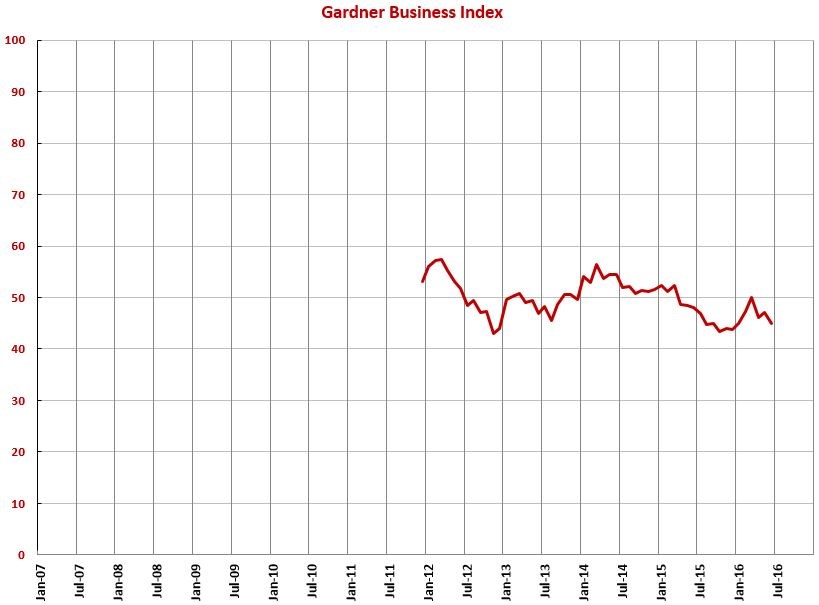GBI for June: 44.9
In June, business conditions in durable goods manufacturing weakened to their lowest point of 2016, but planned capital expenditures have been rising.
#economics
With a reading of 44.9, the Gardner Business Index showed that business conditions in durable goods manufacturing weakened to their lowest point of 2016. In June, durable goods manufacturing contracted at its fastest rate of the year and dropped below the upward trend that began in December.
New orders contracted faster for the third month in a row. Production contracted at its fastest rate of the year. Backlogs contracted at an accelerating rate for the third month in a row. Employment declined for the third month in a row. Despite some moderation in the value of the dollar, exports remained mired in contraction. Supplier deliveries lengthened for the fifth month in a row.
The material prices index has increased dramatically since January, although in June the rate of increase leveled off. Material prices were increasing at their fastest rate since November 2014. Prices received continued to decrease, but the rate of decrease has slowly decelerated since November 2015. Future business expectations have weakened since their peak in March.
Plants with more than 250 employees contracted after expanding the previous three months. Facilities with 100-249 employees contracted for the sixth consecutive month. Facilities with 50-99 employees expanded for the third time in four months. Companies with 20-49 employees contracted for the third month in a row. Companies with 1-19 employees have contracted since June 2015.
Every region contracted in June. The Northeast contracted at the slowest rate. It was followed by the Southeast, which contracted for just the second time in 2016. The North Central-West, West, and North Central-East contracted at similar rates to each other. The South Central recorded its lowest index since November 2015, and its index was below 40 for the second time in three months.
Military was the fastest growing industry in June. It was followed by electronics/computers/telecommunications, HVAC, aerospace, plastics/rubber products, forming/fabricating (non-auto), and other. From slowest to fastest contraction, the other industries were petrochemical processors, custom processors, hardware, machinery/equipment, off-road/construction machinery, medical, automotive, metalcutting job shops, primary metals, industrial motors/hydraulics/mechanical components, power generation, furniture, pumps/valves/plumbing products, oil/gas-field/mining machinery, and ship building.
In addition to the overall durable goods index, we compute indices for a number of technologies or processes. All technologies contracted in June. From slowest to fastest contraction they were finishing, moldmaking, plastics, metalworking, composites, precision machining.
While planned capital expenditures for the next 12 months were at their lowest level since December 2015, they increased almost 26 percent compared with one year ago. That was the third straight month that the month-over-month rate of change increased grew. Therefore, the annual rate of change has contracted at a decelerating rate for four months. This a positive sign for future capital equipment investment.
RELATED CONTENT
-
On Quantum Navigation, EVs, Auto Industry Sales and more
Sandia’s quantum navi, three things about EVs, transporting iron ore in an EV during the winter, going underwater in an EV (OK, it is a sub), state of the UK auto industry (sad), why the Big Three likes Big Vehicles, and the future of logistics.
-
MTU Research to Boost Fuel Economy ~20%
Researchers are using V2X communications and other methods to provide vehicles with a significant increase in fuel economy.
-
What Suppliers Need to Know Right Now
This is a time of reckoning for the auto industry, says Paul Eichenberg. He has some recommendations as to how companies can make their way through it.


.JPG;width=70;height=70;mode=crop)

